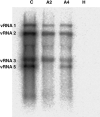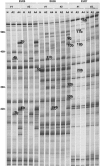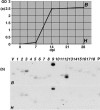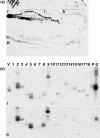Identification of differentially expressed root genes upon rhizomania disease
- PMID: 19019003
- PMCID: PMC6640463
- DOI: 10.1111/j.1364-3703.2008.00498.x
Identification of differentially expressed root genes upon rhizomania disease
Abstract
Rhizomania is one of the most devastating sugar beet diseases. It is caused by Beet necrotic yellow vein virus (BNYVV), which induces abnormal rootlet proliferation. To understand better the physiological and molecular basis of the disorder, transcriptome analysis was performed by restriction fragment differential display polymerase chain reaction (RFDD-PCR), which provided differential gene expression profiles between non-infected and infected sugar beet roots. Two distinct viral isolates were used to detect specific or general virus-induced genes. Differentially expressed genes were selected and identified by sequence analysis, followed by reverse Northern and reverse transcriptase PCR experiments. These latter analyses of different plants (Beta vulgaris and Beta macrocarpa) infected under distinct standardized conditions revealed specific and variable expressions. Candidate genes were linked to cell development, metabolism, defence signalling and oxidative stress. In addition, the expression of already characterized genes linked to defence response (pathogenesis-related protein genes), auxin signalling and cell elongation was also studied to further examine some aspects of the disease. Differential expression was retrieved in both B. vulgaris and B. macrocarpa. However, some candidate genes were found to be deregulated in only one plant species, suggesting differential response to BNYVV or specific responses to the BNYVV vector.
Figures






Similar articles
-
Efficient dsRNA-mediated transgenic resistance to Beet necrotic yellow vein virus in sugar beets is not affected by other soilborne and aphid-transmitted viruses.Transgenic Res. 2008 Apr;17(2):219-28. doi: 10.1007/s11248-007-9092-0. Epub 2007 Apr 13. Transgenic Res. 2008. PMID: 17431806
-
Genome composition analysis of multipartite BNYVV reveals the occurrence of genetic re-assortment in the isolates of Asia Minor and Thrace.Sci Rep. 2020 Mar 5;10(1):4129. doi: 10.1038/s41598-020-61091-2. Sci Rep. 2020. PMID: 32139777 Free PMC article.
-
BNYVV-derived dsRNA confers resistance to rhizomania disease of sugar beet as evidenced by a novel transgenic hairy root approach.Transgenic Res. 2010 Oct;19(5):915-22. doi: 10.1007/s11248-010-9364-y. Epub 2010 Feb 3. Transgenic Res. 2010. PMID: 20127510 Free PMC article.
-
Progress towards the understanding and control of sugar beet rhizomania disease.Mol Plant Pathol. 2009 Jan;10(1):129-41. doi: 10.1111/j.1364-3703.2008.00514.x. Mol Plant Pathol. 2009. PMID: 19161359 Free PMC article. Review.
-
PCR and non-isotopic labeling techniques for plant virus detection.Cell Mol Biol (Noisy-le-grand). 1995 Jul;41(5):639-52. Cell Mol Biol (Noisy-le-grand). 1995. PMID: 7580844 Review.
Cited by
-
Transcriptome Analysis of Beta macrocarpa and Identification of Differentially Expressed Transcripts in Response to Beet Necrotic Yellow Vein Virus Infection.PLoS One. 2015 Jul 21;10(7):e0132277. doi: 10.1371/journal.pone.0132277. eCollection 2015. PLoS One. 2015. PMID: 26196682 Free PMC article.
-
Genome-Wide microRNA Profiling Using Oligonucleotide Microarray Reveals Regulatory Networks of microRNAs in Nicotiana benthamiana During Beet Necrotic Yellow Vein Virus Infection.Viruses. 2020 Mar 12;12(3):310. doi: 10.3390/v12030310. Viruses. 2020. PMID: 32178444 Free PMC article.
-
Deep sequencing-based transcriptome profiling reveals comprehensive insights into the responses of Nicotiana benthamiana to beet necrotic yellow vein virus infections containing or lacking RNA4.PLoS One. 2014 Jan 9;9(1):e85284. doi: 10.1371/journal.pone.0085284. eCollection 2014. PLoS One. 2014. PMID: 24416380 Free PMC article.
-
Expression of the Beet necrotic yellow vein virus p25 protein induces hormonal changes and a root branching phenotype in Arabidopsis thaliana.Transgenic Res. 2011 Jun;20(3):443-66. doi: 10.1007/s11248-010-9424-3. Epub 2010 Jul 3. Transgenic Res. 2011. PMID: 20602166
-
Combined analysis of mRNA and miRNA transcriptomes reveals the regulatory mechanism of Xanthomonas arboricola pv pruni resistance in Prunus persica.BMC Genomics. 2024 Feb 27;25(1):214. doi: 10.1186/s12864-024-10113-8. BMC Genomics. 2024. PMID: 38413907 Free PMC article.
References
-
- Burketova, L. , Stillerova, K. and Feltlova, M. (2003) Immunohistological localization of chitinase and beta‐1,3‐glucanase in rhizomania‐diseased and benzothiadiazole treated sugar beet roots. Physiol. Mol. Plant Pathol. 63, 47–54.
-
- Cassab, G.I. (1998) Plant cell wall proteins. Annu. Rev. Plant Physiol. Plant Mol. Biol. 49, 281–309. - PubMed
Publication types
MeSH terms
LinkOut - more resources
Full Text Sources
Other Literature Sources

